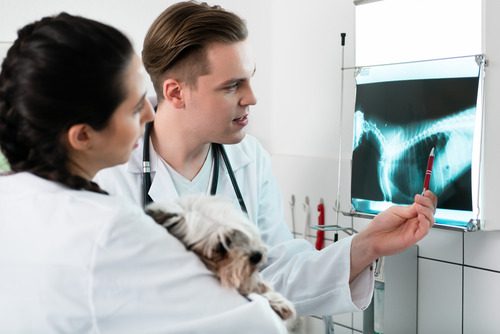IVDD in Dogs
Intervertebral disc disease (IVDD) in dogs is a condition that often affects a pet’s mobility, quality of life, and overall comfort. This spinal disorder develops when the cushioning discs between the vertebrae begin to degenerate, bulge, or rupture, putting pressure on the spinal cord. While some dogs experience only mild discomfort, others may suddenly lose their ability to walk. Early recognition and veterinary support are key to helping dogs with IVDD stay as active and pain-free as possible. If you’re in Silver Spring, MD and require emergency care or a specialty consultation, contact Apex Vets today.

What Is IVDD in Dogs?
IVDD in dogs occurs when the intervertebral discs, those gel-like cushions between the bones of the spine, start to break down or slip out of place. These discs act as shock absorbers, helping the spine move flexibly and safely. When they’re damaged or displaced, they can press on the spinal cord or nerves, leading to pain, weakness, or even paralysis.
This condition is more common in certain breeds, especially those with longer backs and shorter legs, such as Dachshunds, Cocker Spaniels, Beagles, and Shih Tzus. However, IVDD in dogs can affect any breed and may develop gradually or appear suddenly after a minor jump or twist.
There are two types of IVDD in dogs:
- Type I involves a sudden disc rupture and is more common in small breeds.
- Type II is more gradual and typically affects larger breeds as they age.
Both forms of IVDD in dogs can cause serious neurological symptoms if not addressed promptly.
Symptoms of IVDD in Dogs
Symptoms vary based on the severity and location of the disc damage, but many dogs show some combination of the following:
- Reluctance to move, jump, or climb stairs
- Crying out in pain, especially when touched along the spine
- Hunched back or tense abdominal muscles
- Dragging of limbs or difficulty walking
- Sudden weakness or wobbliness in the legs
- Loss of bladder or bowel control
Some dogs with IVDD may appear stiff or hesitant, while others may collapse or be unable to stand. These changes can be subtle or dramatic, depending on how much pressure is being placed on the spinal cord.
Diagnosing IVDD in Dogs
When IVDD in dogs is suspected, your veterinarian will perform a physical and neurological exam to assess spinal reflexes, coordination, and pain response. Based on those findings, imaging is often the next step.
Diagnostic Tools for IVDD
Several advanced imaging techniques are used to confirm IVDD in dogs:
- X-rays can show narrowed spaces between vertebrae, which may suggest a disc issue.
- CT scans and MRI offer more detailed views of soft tissues and the spinal cord.
- Myelography, a type of X-ray using dye injected around the spinal cord, may also be used.
These tests help locate the affected disc and determine how severely the spinal cord is compressed. Once IVDD in dogs is diagnosed, your veterinarian will discuss the best approach based on your dog’s condition and overall health.
Potential Treatment Options for IVDD in Dogs
Treatment for IVDD in dogs depends on how severe the symptoms are and how much the spinal cord is involved. Some dogs respond well to conservative care, while others need surgery to relieve spinal pressure.
Conservative Management
For mild to moderate cases of IVDD in dogs, nonsurgical treatment may include:
- Strict crate rest for 4 to 6 weeks
- Anti-inflammatory medications and pain relief
- Muscle relaxants and supplements to support spinal health
- Physical rehabilitation or acupuncture (under veterinary guidance)
Conservative treatment requires consistent rest and monitoring. If symptoms worsen or don’t improve, surgical intervention may be recommended.
Surgical Intervention
Dogs with severe pain, paralysis, or worsening symptoms may benefit from surgery. Procedures like hemilaminectomy or ventral slot surgery remove part of the disc material and relieve pressure on the spinal cord. Surgery for IVDD in dogs generally has a good prognosis, especially when performed promptly. Recovery often includes physical therapy, supportive care, and follow-up visits.
Recovery and Long-Term Outlook
Recovery from IVDD in dogs varies depending on the severity of the injury, the dog’s age, and whether surgery was required. Many dogs return to a good quality of life, although ongoing support is usually needed.
What to Expect During Recovery
- Post-operative rest is essential for healing. Dogs often need restricted movement for several weeks.
- Rehabilitation such as hydrotherapy, laser therapy, and physical exercises can speed up nerve healing.
- Assistive devices, like slings or carts, may be helpful during early recovery.
Most dogs with IVDD gradually regain strength and coordination. However, some may have permanent mobility issues, especially if they experienced paralysis before treatment. Pet owners should be prepared for lifestyle adjustments, including modifying the home to reduce jumping, adding ramps or non-slip mats, and maintaining a healthy weight to reduce spinal stress.
Can IVDD in Dogs Be Prevented?
While IVDD in dogs isn’t always preventable, especially in genetically predisposed breeds, there are steps you can take to reduce your dog’s risk or delay progression.
Tips to Help Minimize IVDD Risk
- Maintain a healthy weight. Excess weight increases spinal strain.
- Limit jumping. Use ramps for furniture or car access.
- Use a harness instead of a collar. This reduces neck strain during walks.
- Support your dog’s back. When lifting or carrying, always cradle both the chest and rear.
- Choose appropriate exercise. Avoid high-impact activities that could stress the spine.
Routine veterinary care also plays a key role in spotting early signs of IVDD in dogs. Your vet can guide you in creating a plan tailored to your dog’s size, breed, and lifestyle.
When to Contact a Veterinary Specialist
IVDD in dogs can be a complex condition, and not all veterinary clinics are equipped with the tools and experience to handle advanced cases. That’s where a specialty practice like Apex Vets can help.
If you’re in Silver Spring, MD and your dog is experiencing an emergency, such as suddenly showing signs of back pain, struggling to walk, or displaying other neurological changes, reach out to our team. We offer advanced diagnostic imaging, surgical services, and personalized care plans to support your dog’s recovery and comfort. The sooner IVDD in dogs is diagnosed and treated, the better the chances for a positive outcome.
Supporting Your Dog’s Mobility and Comfort
Living with IVDD in dogs means adjusting routines and making long-term decisions that support your pet’s comfort, mobility, and happiness. Whether your dog needs surgery, physical therapy, or simply more supportive care at home, you don’t have to figure it out alone. If you’re in Silver Spring, MD and your pet requires emergency or specialty care, contact Apex Vets today.
